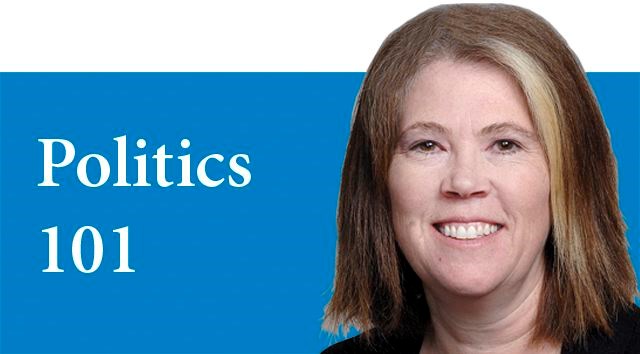Today, I am going to describe the Dual Member Proportional Voting System which is one of the three options that will be on the referendum ballot in October. I started this series a few weeks ago and I have described the Mixed Member Proportional (MMP) Voting System and the Rural-Urban Proportional Voting System. The Prince George Citizen has digital copies of the articles on the website so, if you want to, you can go back and compare the systems.
In order to describe the Dual Member Proportional Voting System, I am going to start by explaining two important ideas that a voter needs to know: how the current system elects a representative and the meaning of the popular vote.
As I have written before, our current system is known by most people as "first-past-the-post" but its more accurate name is Single Member Plurality. The compound name makes up the two parts of the system: "single member" refers to the fact that there is only one MLA per riding (there are 87 ridings in B.C.) and "plurality" means that the winner only needs the most votes, not the majority (more than 50 per cent) in order to become the riding representative. So a riding might be won by a candidate with considerably less than half the votes cast in the riding. For example: Candidate A might get 38 per cent of the votes; Candidate B might get 33 per cent; Candidate C might get 25 per cent and Candidate D might get four per cent. In this case Candidate A wins the seat in the legislature for that riding even though they only received 38 per cent of the votes in the riding.
Once all 87 ridings have chosen an MLA, we count up the number of seats each party has won and the party with the most seats (generally) becomes "the governing party." Single member plurality does not take into consideration how many votes each party received in the whole province. So hypothetically Party 1 might have received 42 per cent of all votes in the province; Party 2 might have received 38 per cent; Party 3 might have received 12 per cent; and other minor parties or independents might make up the remaining eight per cent. These numbers are called the popular vote and currently these numbers do not impact how many MLAs each party gets in the Legislature.
With these two explanations in mind, I can explain the Dual Member Proportional Voting System. In this system two neighbouring electoral districts in semi-urban and urban areas will be amalgamated and we would move from "single member" to "dual member" ridings. Large rural ridings would likely remain single member districts. In dual ridings, each party would nominate two candidates per riding and the parties would order the candidates on the ballot in the order they wish them to be elected. So, if Party 1 wins one of two of the dual member seats the first candidate on the ballot would be the MLA. If they win both of the seats, then both of Party 1's candidates would each win a seat.
In this system, voters would choose the first winner using our current system by "cast(ing) a single vote for the pair of candidates of the political party of their choice" and thus just over half the seats in the Legislature will be awarded in the same way they are now. The second seat in each riding will be allocated based on the total number of seats required for each party to reach their popular vote number and by how well they did in each riding.
If we look at the hypothetical numbers I used earlier Party 1 received 42 per cent of all votes in the province and if they received 23 seats from the first set of MLAs elected, then they would need a total of 14 more MLAs to be allocated a seat in order to reach their proportional number because 42 per cent of 87 seats is (roughly) 37 seats. So if we subtract 23 from 37 we get 14. Those 14 seats would be allocated to ridings by determining in which ridings the party did best. The seat would go to the second candidate listed on the ballot in the riding that received that allocation. I will do one more example. For Party 2 that received 38 per cent of all the votes in the province they should get 33 seats overall. In this hypothetical case if they received 19 seats through the first vote process they would need 14 more seats to reach their proportional vote. The seat would go to the second candidate listed on the ballot in the riding that received that allocation.
I hope that these explanations have been helpful. Over the next few months I will have time to elaborate on some more of the details of each choice.



